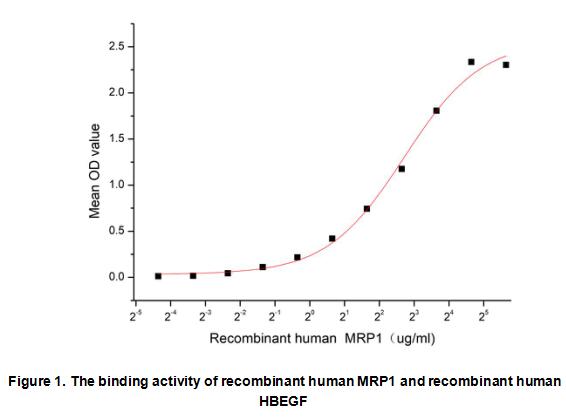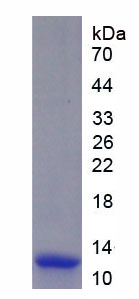Active Motility Related Protein (MRP1)
CD9; TSPAN29; 5H9; BA2; BTCC-1; DRAP-27; GIG2; MIC3; P24; Tetraspanin 29; Cell growth-inhibiting gene 2 protein; Leukocyte antigen MIC3
- Product No.APB097Hu61
- Organism SpeciesHomo sapiens (Human) Same name, Different species.
- Buffer FormulationPBS, pH7.4, containing 0.01% SKL, 1mM DTT, 5% Trehalose and Proclin300.
- Traits Freeze-dried powder
- Purity> 80%
- Isoelectric Point5.9
- ApplicationsCell culture; Activity Assays.
- DownloadInstruction Manual
- UOM 10µg50µg 200µg 1mg 5mg
- FOB
US$ 239
US$ 598
US$ 1196
US$ 3588
US$ 8970
For more details, please contact local distributors!
ACTIVITY TEST

Motility Related Protein (MRP1) is a member of the superfamily of ATP-binding cassette (ABC) transporters. It can enable ATPase-coupled inorganic anion transmembrane transporter activity. Involved in anion transmembrane transport; renal tubular secretion and response to toxic substance. It is an integral component of plasma membrane. Besides, Heparin Binding Epidermal Growth Factor Like Growth Factor (HBEGF) has been identified as an interactor of MRP1, thus a functional binding ELISA assay was conducted to detect the interaction of recombinant human MRP1 and recombinant human HBEGF. Briefly, biotin-linked MRP1 were diluted serially in PBS, with 0.01% BSA (pH 7.4). Duplicate samples of 100 μl were then transferred to HBEGF-coated microtiter wells and incubated for 1h at 37℃. Wells were washed with PBST 3 times and incubation with Streptavidin-HRP for 30 min, then wells were aspirated and washed 5 times. With the addition of substrate solution, wells were incubated 15-25 minutes at 37℃. Finally, add 50 µl stop solution to the wells and read at 450 nm immediately. The binding activity of MRP1 and HBEGF was shown in Figure 1, the EC50 for this effect is 6.55 ug/mL.
USAGE
Reconstitute in 10mM PBS (pH7.4) to a concentration of 0.1-1.0 mg/mL. Do not vortex.
STORAGE
Avoid repeated freeze/thaw cycles. Store at 2-8°C for one month. Aliquot and store at -80°C for 12 months.
STABILITY
The thermal stability is described by the loss rate. The loss rate was determined by accelerated thermal degradation test, that is, incubate the protein at 37°C for 48h, and no obvious degradation and precipitation were observed. The loss rate is less than 5% within the expiration date under appropriate storage condition.
GIVEAWAYS
INCREMENT SERVICES
-
 BCA Protein Quantification Kit
BCA Protein Quantification Kit
-
 Molecular Mass Marker for Protein
Molecular Mass Marker for Protein
-
 Monoclonal Antibody Customized Service
Monoclonal Antibody Customized Service
-
 Polyclonal Antibody Customized Service
Polyclonal Antibody Customized Service
-
 Protein Activity Test Experiment Service
Protein Activity Test Experiment Service
-
 Electrophoretic Mobility Shift Assay (EMSA) Experiment Service
Electrophoretic Mobility Shift Assay (EMSA) Experiment Service
-
 Buffer
Buffer
-
 Lentivirus Packaging Experiment Service
Lentivirus Packaging Experiment Service
-
 Adenovirus Packaging Experiment Service
Adenovirus Packaging Experiment Service
-
 Real Time PCR Experimental Service
Real Time PCR Experimental Service
-
 Spike RBD Protein (S-RBD)
Spike RBD Protein (S-RBD)
-
 Protein G
Protein G
-
 Protein A
Protein A
| Magazine | Citations |
| Nanomedicine | Upstream Hedgehog signaling components are exported in exosomes of cervical cancer cell lines Pubmed: 30265222 |
| Biology-Basel | Biomechanical Properties of Blood Plasma Extracellular Vesicles Revealed by Atomic Force Microscopy 33374530 |







